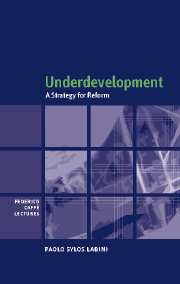Book contents
- Frontmatter
- Contents
- List of figures and tables
- Introduction
- 1 Economic development in a secular perspective
- 2 Culture, institutions and resources
- 3 The inadequacy of mainstream economics to explain development processes: returns and prices
- 4 The inadequacy of mainstream economics to explain development processes: distribution and growth
- 5 Economic relations between developed and underdeveloped countries
- 6 Demographic pressure and the countries of increasing poverty
- 7 Dependent workers, employment and unemployment
- 8 Organizational and institutional innovations
- 9 The problem of corruption
- Conclusion: a strategy for reform
- Bibliography
- Index
2 - Culture, institutions and resources
Published online by Cambridge University Press: 22 September 2009
- Frontmatter
- Contents
- List of figures and tables
- Introduction
- 1 Economic development in a secular perspective
- 2 Culture, institutions and resources
- 3 The inadequacy of mainstream economics to explain development processes: returns and prices
- 4 The inadequacy of mainstream economics to explain development processes: distribution and growth
- 5 Economic relations between developed and underdeveloped countries
- 6 Demographic pressure and the countries of increasing poverty
- 7 Dependent workers, employment and unemployment
- 8 Organizational and institutional innovations
- 9 The problem of corruption
- Conclusion: a strategy for reform
- Bibliography
- Index
Summary
The cultural background: the cases of the United States and Costa Rica
Cultural development is the origin of economic development – this is the leitmotiv of this book. ‘Culture’, however, if conceived in a broad sense, is a vague and elusive concept and vagueness is the enemy of serious scholarship. I will therefore start by considering particular instances of the relations between culture, institutions and economic growth.
In his long discussion of the problems of agricultural development, which is the basis of the economic growth of every society, Adam Smith illustrated the role of the legal institutions regulating transfers of property rights on lands via the market or heredity; at the same time he posed the question of the types of contracts most suitable to favour agricultural development. The basic idea is that such development is promoted mainly by small owners. All regulations and fetters of feudal origin, which keep large areas of land outside the market and forbid the expansion of small owners, represent obstacles to agricultural development.
As for the relations between landowners and tenants, Smith considered a variety of contracts. The most unfavourable to growth were in his opinion those contracts affording tenants no guarantee of duration, such as those of ‘tenants-at-will’, so that cultivators had no interest in introducing improvements. At the other extreme were ‘long leases’, in which cultivators, and their heirs, were entitled to enjoy the fruits of the improvements that they were introducing.
- Type
- Chapter
- Information
- UnderdevelopmentA Strategy for Reform, pp. 33 - 59Publisher: Cambridge University PressPrint publication year: 2001



